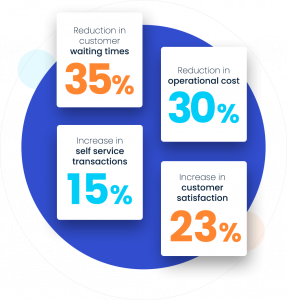In today’s competitive business landscape, providing an outstanding customer experience (CX) is supreme. CX encompasses every customer interaction with a company, from browsing a website to receiving support.
According to a recent study, 86% of buyers are willing to pay more for a better CX, highlighting its critical importance.
This article dives into the fundamental elements of customer experience, which serve as the building blocks for creating positive and lasting impressions.
Understanding these elements is like holding the secret key to success. They include aspects like personalized service, seamless communication, and reliability.
By mastering these elements, businesses can establish deeper connections with their customers, increasing satisfaction and loyalty. Let’s explore the critical components of an exceptional customer experience.
Whether you’re a seasoned business owner or just starting, grasping these elements will undoubtedly steer your company toward more tremendous success.
7 Key Elements of Customer Experience

In the world of business, understanding the customer experience key elements is like holding the compass to success.
These fundamental elements serve as the foundation for crafting exceptional customer interactions. They encompass every touchpoint a customer has with a business, from the initial introduction to the final transaction and beyond.
Let’s look at these in detail for a better understanding of aspects of customer experience.
1. Seamless Multichannel Communication
In today’s digital era, customers expect to interact with businesses effortlessly through multiple channels.
Seamless multichannel communication is essential for providing a consistent and unified customer experience across all touchpoints, whether it be phone, email, social media, or in-person interactions.
By integrating these communication channels, businesses can ensure that customers receive a coherent and efficient service regardless of how they connect.
This approach enhances the overall customer experience and builds trust and loyalty by demonstrating reliability and responsiveness.
Integration Of Communication Channels
In today’s digital age, customers interact with businesses through various channels, including phone, email, social media, and chat. Ensuring these channels are integrated is vital for a seamless customer experience.
Integrated communication channels allow customers to switch methods without repeating themselves, providing a smooth and efficient service.
Omnichannel Customer Journey Mapping
Mapping the omnichannel customer journey is another crucial component of customer experience. This involves understanding and documenting all customer touchpoints with your business across different channels.
This allows companies to identify pain points and opportunities to boost the customer journey.
Unified multichannel communication ensures that customers receive consistent and efficient service regardless of how they interact with your business. This consistency is critical to customer satisfaction and loyalty, as it reinforces trust and reliability.
2. Personalization and Customization
When it comes to customer experience management, personalization and customization stand as paramount elements and essential customer experience strategies.
They elevate interactions from transactional to meaningful, forging a deep connection between the customer and the brand.
- Tailored Recommendations: Understanding customer preferences allows businesses to offer products or services that align perfectly with their needs. This tailored approach showcases a commitment to the customer’s satisfaction and creates a memorable experience.
- Precision in Marketing: Personalized marketing campaigns speak directly to the individual, resonating more personally. This targeted approach demonstrates a keen understanding of the customer’s interests and affirms that their unique needs are valued.
Prioritizing personalization and customization within customer experience management yields manifold benefits for businesses:
- Enhanced Customer Loyalty: Businesses foster a sense of belonging by demonstrating a genuine interest in their preferences, leading to increased customer retention.
- Higher Customer Satisfaction: Tailored recommendations and personalized marketing efforts result in happier, more satisfied customers who feel understood and valued.
- Increased Sales and Revenue: Customized offerings are more likely to meet customers’ specific needs, leading to higher conversion rates and increased revenue streams.
Incorporating these elements of customer experience, along with strategic practices like customer journey optimization, heightens customer satisfaction and fortifies brand loyalty, ultimately driving business success.
3. Consistency Across Touchpoints
The components of customer experience encompass various facets, with consistency across touchpoints playing a pivotal role in ensuring seamless and reliable interaction.
- Brand Consistency: This involves maintaining a uniform brand image across all touchpoints. Visual elements like digital signage, tone of communication, and overall brand identity should resonate consistently. This builds trust and recognition, regardless of how customers engage with the business.
- Messaging Consistency: Clear and coherent messaging is fundamental. It reinforces the brand’s values and promises. No matter the channel of interaction—be it the website, social media, or in-person—the message should remain steadfast. This fosters trust and reliability in the eyes of the customer.
Consistency across touchpoints serves as a cornerstone in the customer experience journey. It instills trust, reinforces brand identity, and ensures customers receive a seamless and uniform message, regardless of how they engage with the business.
This consistency is not just a practical aspect; it’s a strategic move that contributes to the overall positive customer experience benefits.
This unity across channels enhances customer satisfaction and solidifies brand loyalty, ultimately contributing to the enterprise’s overall success.
4. Ease of Use and Accessibility
Two critical elements of good customer service are the ease of use and accessibility of products or services.
These components ensure that customers can interact with a business smoothly and inclusively and are a crucial part of customer experience solutions.
- User-Friendly Interfaces: A user-friendly interface is the cornerstone of a positive customer experience. It means that websites, apps, or physical products should be designed with simplicity and intuitiveness in mind. Customers should easily navigate and accomplish tasks without unnecessary complexity or confusion.
- Accessibility for Diverse Audiences: Inclusivity is vital. Businesses must cater to diverse audiences, including those with disabilities. This involves providing options like screen readers, alternative text for images, and other accessibility features.
By prioritizing ease of use and accessibility, businesses enhance customer satisfaction and broaden their reach to a broader audience.
These elements of good customer service exemplify a dedication to delivering a positive and inclusive experience for every customer, fostering loyalty and long-term success.
5. Predictive Analytics for CX Improvement
 Employing predictive analytics is a cutting-edge approach that significantly enhances the customer experience and is a part of crucial elements of customer experience.
Employing predictive analytics is a cutting-edge approach that significantly enhances the customer experience and is a part of crucial elements of customer experience.
It involves foreseeing customer behavior and preferences and proactively addressing potential issues.
- Predicting Customer Behavior and Preferences: By analyzing past data and patterns, businesses can make informed predictions about what their customers will likely do or prefer in the future. This allows for tailored recommendations and personalized experiences that resonate with individual customer needs.
- Anticipating and Proactively Addressing Issues: Predictive analytics goes beyond foreseeing positive behaviors. It also enables businesses to identify and mitigate potential problems before they occur. This proactive approach shows customers that their concerns are valued and addressed promptly.
Implementing predictive analytics and digitization into customer experience strategies transforms interactions from reactive to proactive.
It allows businesses to stay ahead of customer needs, providing tailored solutions and experiences.
This not only boosts satisfaction but also builds trust and loyalty.
6. Customer Relationship Management
Effective Customer Relationship Management (CRM) is the cornerstone of a successful business. CRM involves managing all your company’s interactions with current and potential customers. Understanding customer needs and behaviors helps businesses build strong, lasting relationships.
A robust CRM system allows businesses to store customer information, track interactions, and manage customer data effectively.
This system helps personalize the customer experience by keeping track of purchase history and preferences, ensuring that every interaction feels personal and meaningful.
When businesses invest in CRM, they can anticipate customer needs, provide timely responses, and deliver exceptional service.
Leveraging CRM tools can significantly enhance companies’ customer experience. These tools enable seamless communication and help resolve issues quickly, which is essential to customer service.
Effective CRM practices also contribute to higher customer satisfaction and loyalty, making it a vital element of customer experience.
7. Feedback Mechanisms
Feedback mechanisms are indispensable for any business aiming to refine and enhance customer experience components. By actively seeking and responding to customer feedback, companies can gain valuable insights that drive continuous improvement and innovation.
These mechanisms help identify areas for improvement and demonstrate a commitment to listening to and valuing customer opinions.
Below, we examine the crucial aspects of feedback mechanisms and how they contribute to a superior customer experience.
Your Voice Matters: The Importance of Their Feedback
Customer feedback is crucial to improving the components of customer experience. When customers share their opinions, they provide valuable insights into what works well and needs improvement.
Listening to customer feedback shows that a business values its customers’ opinions and is committed to improving their experience.
Opening The Doors: Creating Effective Channels for Feedback
Creating effective feedback channels is essential for gathering meaningful insights. These can include surveys, feedback forms, social media interactions, and direct communication channels.
Businesses should make it easy for customers to share their thoughts and ensure they feel heard.
Turning Feedback into Action: Using Their Input to Improve
Once feedback is collected, it is crucial to act on it. Businesses must analyze the data, identify common issues, and implement changes addressing customer concerns.
By turning feedback into action, companies can improve key elements of their customer experience and demonstrate a commitment to continuous improvement.
By leveraging these elements of customer experience and employing effective strategies to measure customer experience, businesses can stay at the forefront of customer-centric innovation, setting them apart in today’s competitive landscape.
Case Studies
Chick-fil-A: Elevating Fast-Food Service
Chick-fil-A stands as a beacon of exceptional customer experience in the fast-food industry. Their commitment to “second-mile service” is exemplified through friendly, efficient, and genuinely caring staff.
For instance, a 96-year-old WWII veteran visited a Maryland Chick-fil-A, distressed by a flat tire during his drive.
Manager Daryl Howard swiftly stepped in, changing the tire in just 15 minutes. This act of exemplary service showcased Chick-fil-A’s legendary commitment to customers.
Amazon: Pioneering E-Commerce CX
Amazon revolutionized e-commerce and set a gold standard for customer experience. Their platform’s user-friendly interface, extensive product range, and reliable delivery services have earned them global acclaim.
Amazon’s personalized recommendation engine analyzes customer behavior to offer tailored product suggestions, enhancing user satisfaction.
Moreover, their customer service is prompt and effective, swiftly addressing any concerns.
A testament to their commitment, during a major snowstorm, an Amazon delivery driver walked through a live police standoff to ensure a timely delivery, showcasing their unwavering dedication to customer satisfaction.
Customer experience elements – FAQs
What are the 4 Ps of customer experience?
The 4 Ps of customer experience are Personalization, Predictive Analytics, Proactivity, and Privacy. These elements help businesses tailor experiences, anticipate needs, engage proactively, and ensure data security.
What are the 3 Rs of customer experience?
The 3 Rs of customer experience are Responsiveness, Reliability, and Relationship. These focus on timely support, consistent service, and strong customer connections.
Final Words
Understanding and mastering the fundamental elements of customer experience is crucial for any business looking to thrive in today’s market.
Businesses can significantly enhance their customer interactions by focusing on effective customer relationship management, implementing robust feedback mechanisms, and ensuring seamless multichannel communication.
These efforts improve customer satisfaction and loyalty and contribute to long-term success and growth.
Remember, a positive customer experience is not just a one-time effort but an ongoing commitment to understanding and consistently meeting customer needs. Adopt these elements and watch your business reach new heights of success.
